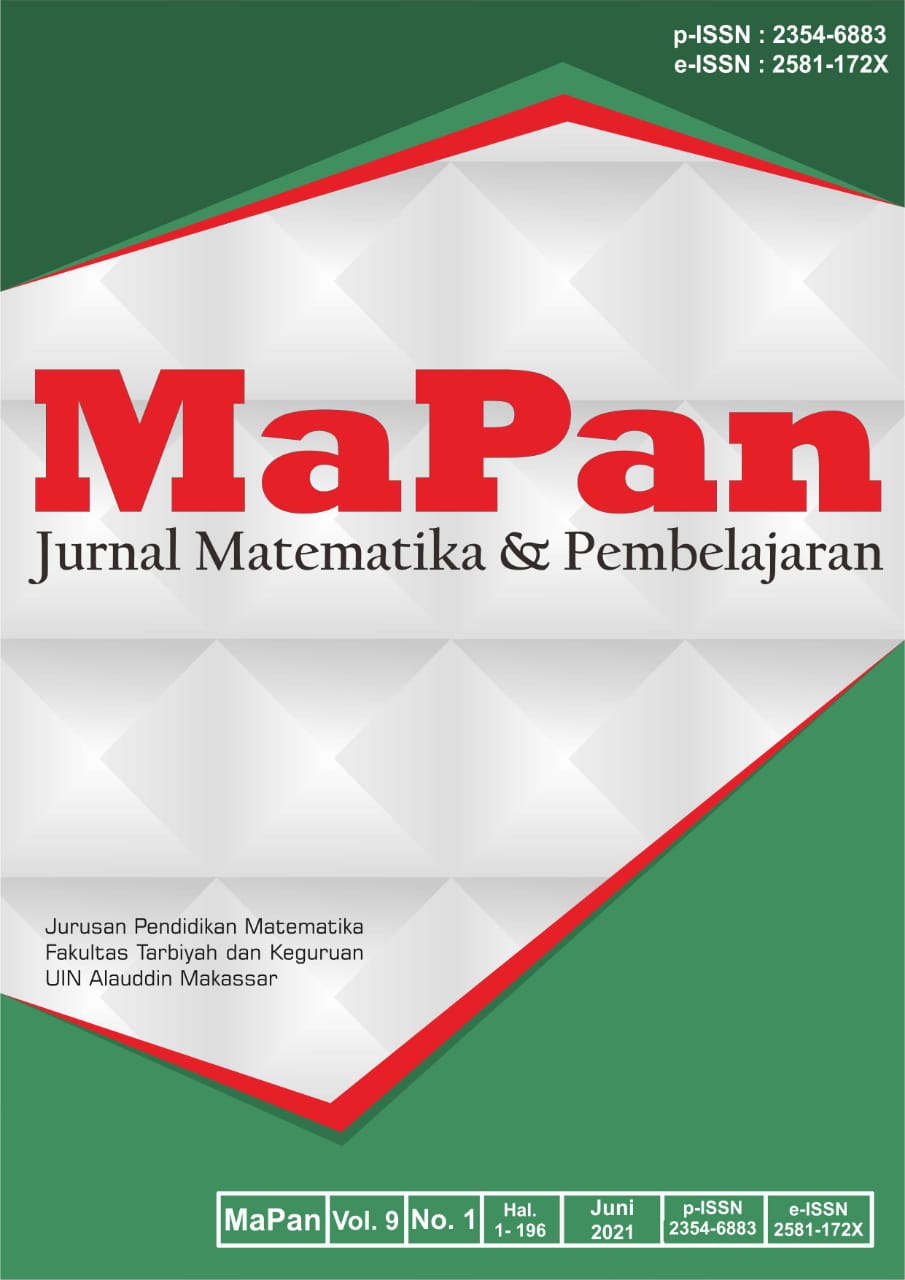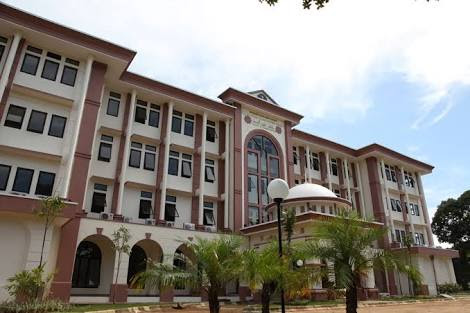DEVELOPING PISA-LIKE PROBLEMS TO ASSESS STUDENTS’ MATHEMATICAL COMMUNICATION AND PROBLEM SOLVING ABILITIES
Abstract
This research aims to produce PISA-like problems that are valid, practical, and effective for assessing students' mathematical communication and problem solving abilities. This research type is formative evaluation development by Tessmer, including expert review, one-to-one, small group, and field test. The subject of this research is 60 students of Year 9 at SMP Negeri 19 Percontohan Banda Aceh, Indonesia. The results of this study yielded 15 PISA-like problems that are 1) valid because experts state that the set of questions developed is based on a strong theoretical basis, almost all problems have valid criteria, and the set of problems has high reliability; 2) practical because teachers agree that the problems can assess students' mathematical communication and problem solving abilities; 3) effective because mathematical communication and problem solving abilities of students meet PISA levels and students give positive responses to PISA-like problems. The implication of this research is that mathematics teachers can use this problem to familiarize students in answering PISA-like problems, primarily to assess mathematical communication and problem solving abilities.Downloads
References
Ahyan, S., Zulkardi, Z., & Darmawijoyo, D. (2014). Developing mathematics problems based on PISA level of change and relationships content. Journal on Mathematics Education, 5(1), 47–56. https://dx.doi.org/10.22342/jme.5.1.1448.47-56.
Amalia, A. R., Rusdi, R., & Kamid, K. (2021). Pengembangan soal matematika bermuatan HOTS setara PISA berkonteks pancasila. Jurnal Cendekia: Jurnal Pendidikan Matematika, 5(1), 01–19. https://doi.org/10.31004/cendekia.v5i1.386.
Anisah, A., Zulkardi, Z., & Darmawijoyo, D. (2011). Pengembangan soal matematika model PISA pada konten quantity untuk mengukur kemampuan penalaran matematis siswa sekolah menengah pertama. Jurnal Pendidikan Matematika Sriwijaya, 5(1). https://doi.org/10.22342/jpm.5.1.333.
Baroody, A. J. (1993). Problem solving, reasoning, and communicating, K-8: helping children think mathematically. New York: MacMilan Publishing Company.
Charmila, N., Zulkardi, Z., & Darmawijoyo, D. (2016). Pengembangan soal matematika model PISA menggunakan Konteks Jambi. Jurnal Penelitian Dan Evaluasi Pendidikan, 20(2), 198–207. https://doi.org/10.21831/pep. v20i2.7444.
De Lange, J. (2006). Mathematical literacy for living from OECD-PISA perspective. Tsukuba Journal of Educational Study in Mathematics, 25(1), 13–35. Retrieved from http://www.human.tsukuba.ac.jp/~mathedu/2503.pdf.
Guilford, J. P. (1956). Fundamental statistics in psychology and education. New York: Mc Graw-Hill Book Co. Inc.
Hayat, B., & Yusuf, S. (2011). Mutu pendidikan. Jakarta: Bumi Aksara.
Jannah, R. D., & Putri, R. I. I. (2019). Soft tennis and volleyball contexts in asian games for PISA-LIKE mathematics problems. Journal on Mathematics Education, 10(1), 157–170. https://doi.org/10.22342/jme.10.1.5248.157-170.
Jurnaidi, & Zulkardi. (2013). Pengembangan soal model PISA pada konten change and relationship untuk mengetahui kemampuan penalaran matematis siswa sekolah menengah pertama. Jurnal Pendidikan Matematika, 7(2), 37–54. https://doi.org/10.22342/jpm.8.1.1860.25-42.
Kaur, B., & Toh, T. L. (2012). Reasoning, communication and connections in mathematics: yearbook 2012, association of mathematics educators (Vol. 4). World Scientific.
Kemdikbud. (2016). Peraturan menteri pendidikan dan kebudayaan. Jakarta: Kementerian Pendidikan dan Kebudayaan.
Kurniawati, I., & Kurniasari, I. (2019). Literasi matematika siswa dalam menyelesaikan soal PISA konten space and shape ditinjau dari kecerdasan majemuk. MATHEdunesa, 8(2), 441–448. Retrieved from https://jurnalmahasiswa.unesa.ac.id/index.php/mathedunesa/article/view/28917.
NCTM. (2000). Principles and standards for school mathematics. Reston, Virginia: NCTM.
Nieveen, N. (1999). Prototyping to reach product quality. Design Approaches and Tools in Education and Training, 125–135.
OECD. (2013). PISA 2012 Result: ready to learn students’ engagement and self-beliefs (3).
Putra, Y. Y., Zulkardi, Z., & Hartono, Y. (2016a). Pengembangan soal matematika model PISA konten bilangan untuk mengetahui kemampuan literasi matematika siswa. Jurnal Elemen, 2(1), 14–26. Retrieved from https://e-journal.hamzanwadi.ac.id/index.php/jel/article/view/175.
Putra, Y. Y., Zulkardi, Z., & Hartono, Y. (2016b). Pengembangan soal matematika model PISA level 4, 5, 6 menggunakan konteks lampung. Kreano, Jurnal Matematika Kreatif-Inovatif, 7(1), 10–16. https://doi.org/10.15294/kreano.v7i1.4832.
Saputri, N. W., Turidho, A., Zulkardi, Z., Darmawijoyo, D., & Somakim, S. (2020). Desain soal PISA konten uncertainty and data konteks penyebaran covid-19. EDU-MAT: Jurnal Pendidikan Matematika, 8(2), 106–118. https://doi.org/10.20527/edumat.v8i2.8564.
Stacey, K. (2011). The PISA view of mathematical literacy in Indonesia. Indonesian Mathematical Society Journal on Mathematics Education, 2(2), 95–126. https://doi.org/10.22342/jme.2.2.746.95-126.
Tessmer, M. (1993). Planning and conducting formative evaluation. London: Kogan Page.
Usnul, U., Johar, R., & Sofyan, H. (2019). Potential effect of PISA equivalent questions using the context of aceh traditional houses. JRAMathEdu (Journal of Research and Advances in Mathematics Education), 4(2), 89–100. https://doi.org/10.23917/jramathedu.v4i2.8362.
Wardani, S. (2011). Modul matematika SMP program bermutu. Instrumen Penilaian Hasil Belajar Matematika SMP: Belajar Dari PISA Dan TIMMS. Kementrian Pendidikan Nasional.
Widjaja, W. (2011). Towards mathematical literacy in the 21st century: Perspectives from Indonesia. Journal on Southeast Asian Mathematics Education, 1(1), 75–84. https://doi.org/10.46517/seamej.v1i1.12.
Wijaya, A. (2012). Pendekatan matematika realistik. Yogyakarta: Graha Ilmu.
Yansen, D., & Putri, R. I. I. (2019). Developing PISA-Like mathematics problems on uncertainty and data using asian games football context. Journal on Mathematics Education, 10(1), 37–46. https://doi.org/10.22342/jme.10.1.5249.37-46.
Zakaria, E. (2007). The effect of a thinking strategy approach through visual representation on achievement conceptual understanding in solving mathematical word problems. Asian Social Science, 8(16), 30–37. https://doi.org/dx.doi.org/10.5539/ass.v8n16p30.
Zulkardi, Z. (2002). Developing a learning environment on realistic mathematics education for Indonesian student teachers. Doctoral Dissertation. University of Twente, Enschede.
Copyright (c) 2021 T. Marwanda, Yusrizal, Rahmah Johar

This work is licensed under a Creative Commons Attribution 4.0 International License.


